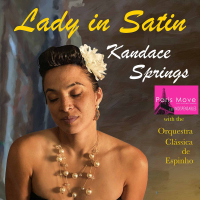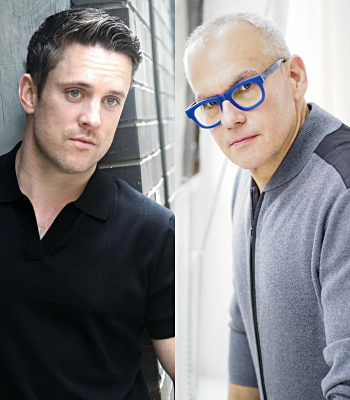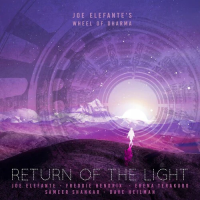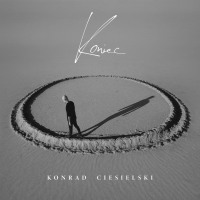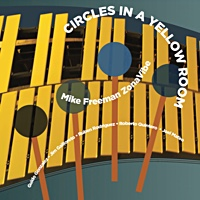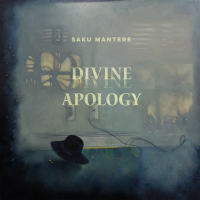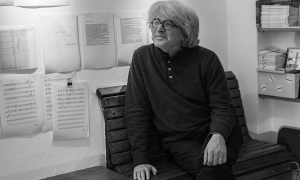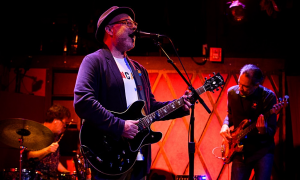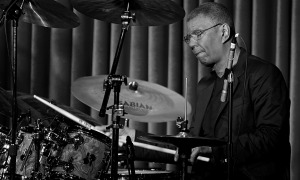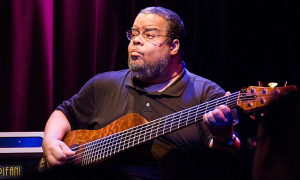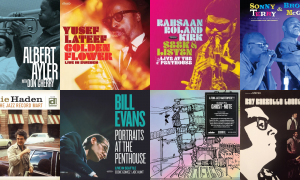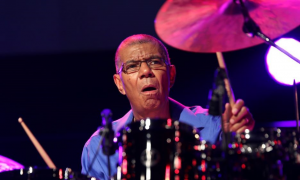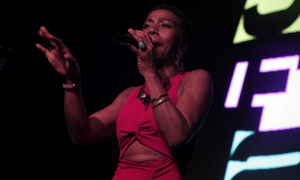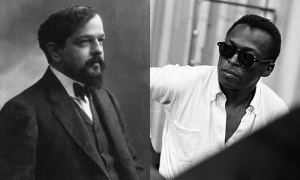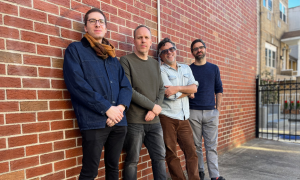Home » Jazz Articles » Interview » Benjamin Boone: The Poetry of Jazz and the Ghanaian Connection
Benjamin Boone: The Poetry of Jazz and the Ghanaian Connection
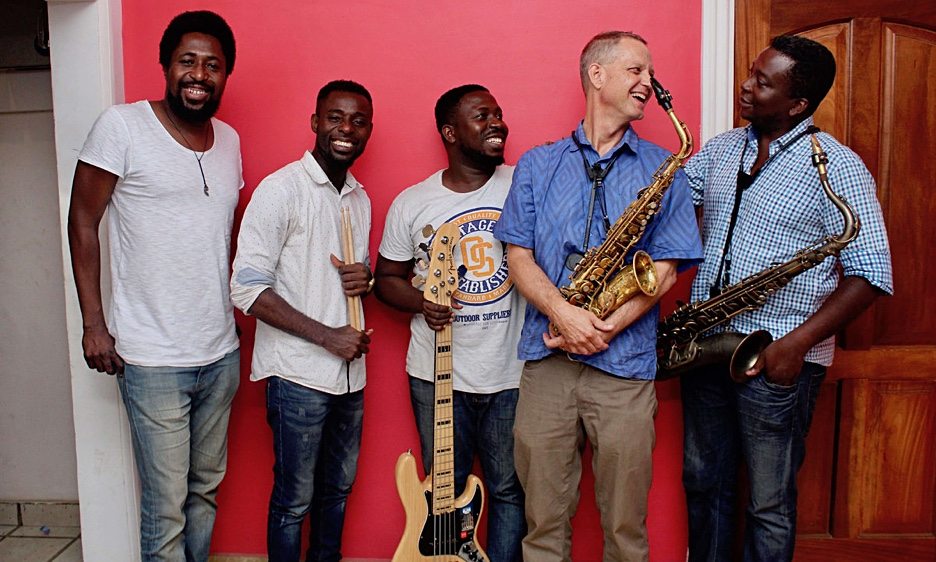
If you're saxophonist-composer Benjamin Boone, the answer's neither of the above. Instead, Boone has opted for a set with a Ghanaian jazz group so hot they leave smoke trails. The record is called Joy and it's Joy by name, Joy by nature. That's the first thing that hits you with the CD. The sheer joy of making music together, communally.
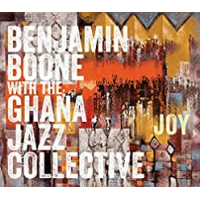 This is no big star plus locals gig. The empathy between Boone and the band's four members is palpable on each of Joy's seven cuts and the Benjamin Boone with the Ghana Jazz Collective is indeed a force of nature. Some marriages are made in heaven but this one was made in Ghana while Boone was on a year long Fulbright Scholarship at the University of Ghana in Accra.
This is no big star plus locals gig. The empathy between Boone and the band's four members is palpable on each of Joy's seven cuts and the Benjamin Boone with the Ghana Jazz Collective is indeed a force of nature. Some marriages are made in heaven but this one was made in Ghana while Boone was on a year long Fulbright Scholarship at the University of Ghana in Accra. As well as being a powerful improviser on alto and soprano saxophones and a fine jazz composer, Boone straddles the worlds of jazz, classical music and academia. For some time, he has been a Professor of Music at California State University in Fresno, where he teaches theory and composition.
Though he acknowledges that it can get hard justifying this triangle of roles—jazz, classical, academia—to himself as much as to others, Boone says, "Even at an early age, I knew that being a jazz musician made me a better composer, being a composer made me a better improviser and being a scholar made me curious about why all this was happening anyway."
It was that same curiosity that took Boone to Ghana in 2017. His interest in West Africa focused on the cultural and linguistic traditions that were brought to the USA by African slaves. Specifically, he wanted to understand how this heritage was mediated through the development of jazz into a musical form.
 "My dissertation ended up analyzing spoken American-English from a musical perspective but it began more simply with me wondering whether there was any relationship between how earlier blues musicians spoke and how they played and improvised."
"My dissertation ended up analyzing spoken American-English from a musical perspective but it began more simply with me wondering whether there was any relationship between how earlier blues musicians spoke and how they played and improvised." Listening to interviews recorded by Alan Lomax with these musicians at the Library of Congress, Boone was moving into an area of research developed by academics and musicians such as Gerhard Kubik, David Evans and Paul Oliver. Kubik, in his Grove entry on the 'blue note,' actually quotes from Boone's own work in the article. "When I was listening to those interviews, I would try to hear what they were saying as music," Boone tells me. "But I wanted to solidify that their talk and music were related."
Here it gets technical but to keep it brief, working with a scholar in Maryland with access to advanced computer programs, confirmed his thesis. That was the starting point and that led him to the study of tone languages spoken in West Africa, ways of speaking that relate intimately to the music of those areas. As Boone says, Africa was calling him.
His thesis was that the neural pathways of our brains are mapped, in part, according to the kinds of language we speak and that must affect cognition and the way a person practices pitch. This is where academia and creative imagination come together. Boone tried to imagine what would occur when a person speaking a tone language from West Africa was brought in slavery to the Americas, separated from others of their tribe, forbidden to speak their own language and then required to speak the language of their captors. Boone explains:
"What happens when you take the English language with its phonetic character, all of its linguistic meanings and origins and process it through the speech template in a brain that, in its physical structures, is shaped for speaking West African tone languages? Simply, what you end up with is blue notes. That's just what I found in the speech of these early jazz improvisers."
This led to a further question—what then takes place when that person is forbidden to use their own instruments, such as the drum out of fear it might incite rebellion, but is given western instruments to play? The answer to that is worth a whole lot more than $64,000!
"I thought, 'Who were the early creators of jazz? What was their linguistic background? What was their musical background?' So, of course, I had to go to Ghana because so many of the slaves who came to America came through Ghana or were Ghanaian or from sub-Saharan Africa."
Remarkably, Boone succeeded in obtaining a Fulbright Fellowship to conduct research and teach study in Ghana, while his wife Alice—a journalist—also obtained a Fulbright to teach and research journalism at the same university. I ask Boone what links he discovered between the music of Ghana and how jazz developed in the USA. The subject is, of course, huge and Boone, thankfully opts to focus on one very clear example—pitch and rhythmic synchrony.
"Jazz is really a communication," he says. "It's not just saying, 'This is me—I'm doing my thing.' It's a group of people coming together, saying, 'We want to work together.' So, in Ghana there was a ton of this kind of rhythmic synchrony going on just in the visual cues. When I was on the stand with the Ghana Jazz Collective, everyone was nodding their head and blinking, their eye movements in sync. Everyone was saying, 'We are this unit. We are unified in what we are doing.' That came across in the playing too."
So, how might this differ, say in the USA or Europe with a group of jazz musicians?
"In the US, someone might intentionally do a rhythm against what the bassist is doing to create this multi-layered counterpoint effect. In Ghana, they might do that but they are going to start by being completely in sync with what you are doing and then taking it somewhere else. So, there was this mind-blowing, real-life example of rhythmic and pitch synchrony that was my dissertation research twenty years ago manifest in these performances with the Ghanaian jazz musicians."
Boone's studies in Ghana focused primarily on traditional Ghanaian music, which in turn led to reflections upon how retentions from African music might have influenced early jazz.
"I think that the main aspect is the communal, improvisational aspect. In today's jazz music, you'll hear the band play the melody and one person solo for a time, then another and so on. But if you go to the early history of jazz and even to ragtime or some early spirituals or early blues, the taking of one big long feature solo isn't the thing. People were constantly reacting and responding. This person will make this little interjection for a while and then give it over to this person who passes to the next. I may be getting out of my league here but it seems to me that traditional Ghanaian music has always had that. That probably came over to the United States, that idea of the community making music rather than the individual. You're thought to be rather long-winded if you take too long."
One of the things that most impressed Boone with the Ghana Jazz Collective was their capacity to listen and to respond instantly to the subtlest of musical cues. For him, this is something that is almost a cultural given and one seen in all aspects of human interaction. Growing up in North Carolina, "slave central" as he calls it, Boone had wondered how he would be received.
"My experience with the Ghanaians was that they see that as the ancient past. They saw me as a person interested in their culture. Particularly because I am a musician. That made me a member of the musician family and that makes us brothers. If I brought that up, they would just laugh and say, 'you are not responsible for your father's sins.'"
He tells me that the Ghanaian word Akwaaba means 'welcome' but more in the sense that one has the other's complete attention and that connection is sought at "some higher level as human beings." It's something that, for Boone, continues when music is made together. "I think that comes out in the music," he says. "Everyone is expected to participate in traditional music in some shape or form. If you are a little kid you are expected to go up with the master musicians and play the bell or dance or take your turn at the drum."
Boone was also pleasantly surprised to discover a thriving jazz scene, at least in Accra, where he was based.
"There's a club called +233 Jazz Bar, very cosmopolitan, which I wrote a tune on the album about," he tells me, which is where he came across the Ghanaian Jazz Collective. "They know traditional music but to them that is old music," Boone says. "That's what they grew up with. That's looking back. To them jazz is looking forward. These are very well-known musicians in Africa and they excel at American jazz. I think it's really important for people to hear these guys and how well they play jazz because it breaks up the stereotype when we think about Ghanaian musicians."
Boone says he came to jazz first off through fusion stars like Grover Washington, Jr. and Chuck Mangione. There is certainly something of that kick about Joy that one gets from the best jazz-funk/fusion and something of that sense of form being as important as the solos. Early-mid-period Jazz Crusaders might be a good reference point.
Joy features four Boone originals plus a reharmonization of Herbie Hancock's "Maiden Voyage," the title track by saxophonist Gerry Niewood and "Curtain of Light" by Jonovan Cooper, Head of Jazz at Addis Ababa University. The album leads off with Boone's swirling musical portrait of his wife, "The Intricacies of Alice." This is very much a group performance, with Boone trading phrases with fellow saxophonist Bernard Ayisa before pianist Victor Dey Jr. takes the main solo. Again one is left not with the feeling of piano plus rhythm but of a constant interaction between Dey, bassist Bright Osei and drummer Frank Kissi.
"Slam," with wordless vocals from singer Sandra Huson, was inspired by Japanese fusion pianist Hiromi and has much of that artist's sense of dynamics. More than that, its pacing and rhythms shift to create a series of different moods. Ayisa is particularly strong here, while Huson functions like third horn harmonizing perfectly with the two saxophones. Listen too to the way that Boone builds his solo and how piano, bass and drums follow and even anticipate every turn. As for Dey Jr.'s dissonant closing chords, this is some keyboard player. "The 233 Jazz Bar," on the other hand, is a fine, loping groove with some Marcus Miller-inspired bass from Bright Osei and a beautifully-weighted solo from Boone.
But perhaps the best track on the record is "Curtain of Light." It's based upon an ancient Ethiopian mode. Its composer, Jonovan Cooper, uses the mode to construct a piece that moves through a set of variations on a theme, each variation given its own particular stamp first by Ayisa, then Dey Jr., then Boone and finally by drummer Frank Kissi—for me, the album's revelation. But each musician is his own (and her own) person, each distinctive in their own fashion. Joy could be an 'in-car favourite' for years to come, assuming I ever get to leave home again!
But it was the empathy that he found playing with the Ghana Jazz Collective that most impressed Boone, a quality he cannot help but compare with some jazz musicians at home.
"Maybe it's symptomatic of people doing overdubs in a studio rather than playing live. Maybe it has to do with ego but, it seems to me, a lot of jazz musicians think of themselves when they play rather than try to respond to what the group is doing. But at every given moment I was playing in Ghana I had the sense that they were listening beyond belief and ready to respond and this is going to be a communication. Sometimes, that has not been my experience playing in Europe or America. Sometimes people are on autopilot or they are trying to prove something when they play, so they get a bit verbose."
 Boone's classical pieces have been performed in thirty-five countries and can be found on twenty-eight recordings. His long-term partnership with German violinist, Stefan Poetzsch, resulted in the 2001 CD Eastbound-Westbound/Ostwärts-Westwärts, representing a meeting between classical composition, jazz and free improvisation. Some of the pieces on the justly praised collaboration with poet Benjamin Boone & Philip Levine, The Poetry of Jazz— A Dozen Dawn Songs, Plus One," "By the Waters of the Llobregat" and "Our Valley"—certain draw on both jazz and classical music. Boone is clearly as comfortable working discreetly in jazz or classical music or on world music projects, as he is bringing these musics together. His work-rate seems, by any standards, phenomenal, as a visit to his website attests.
Boone's classical pieces have been performed in thirty-five countries and can be found on twenty-eight recordings. His long-term partnership with German violinist, Stefan Poetzsch, resulted in the 2001 CD Eastbound-Westbound/Ostwärts-Westwärts, representing a meeting between classical composition, jazz and free improvisation. Some of the pieces on the justly praised collaboration with poet Benjamin Boone & Philip Levine, The Poetry of Jazz— A Dozen Dawn Songs, Plus One," "By the Waters of the Llobregat" and "Our Valley"—certain draw on both jazz and classical music. Boone is clearly as comfortable working discreetly in jazz or classical music or on world music projects, as he is bringing these musics together. His work-rate seems, by any standards, phenomenal, as a visit to his website attests. The Poetry of Jazz Volumes One & Two and Joy are substantial and very different additions to the jazz catalogue. That said, I have a sneaking suspicion that Boone is just getting started.
Tags
Interview
Benjamin Boone with the Ghana Jazz Collective
Duncan Heining
United States
Benjamin Boone
Ghana Jazz Collective
Alan Lomax
Grover Washington Jr.
Chuck Mangione
Jazz Crusaders
Herbie Hancock
Gerry Niewood
Jonovan Cooper
Bernard Ayisa
Victor Dey Jr.
Bright Osei
Frank Kissi
Sandra Huson
Hiromi
Marcus Miller
Stefan Poetzsch
Philip Levine
PREVIOUS / NEXT
Support All About Jazz
 All About Jazz has been a pillar of jazz since 1995, championing it as an art form and, more importantly, supporting the musicians who make it. Our enduring commitment has made "AAJ" one of the most culturally important websites of its kind, read by hundreds of thousands of fans, musicians and industry figures every month.
All About Jazz has been a pillar of jazz since 1995, championing it as an art form and, more importantly, supporting the musicians who make it. Our enduring commitment has made "AAJ" one of the most culturally important websites of its kind, read by hundreds of thousands of fans, musicians and industry figures every month.






